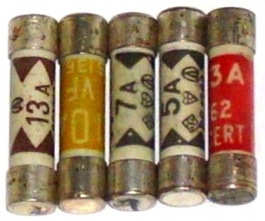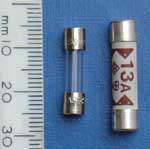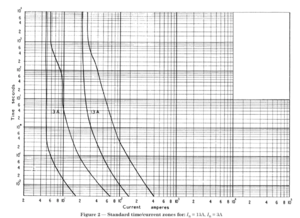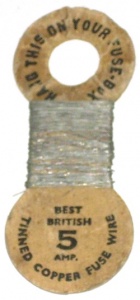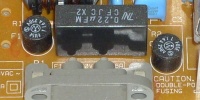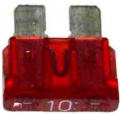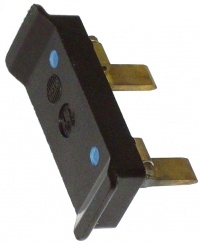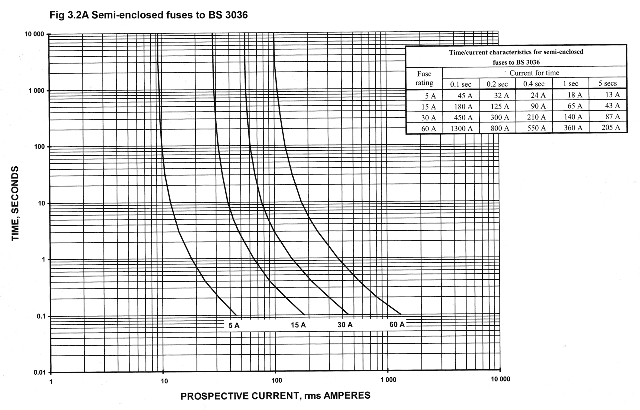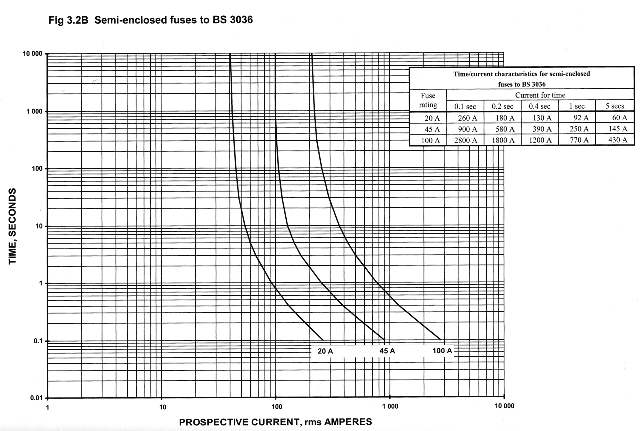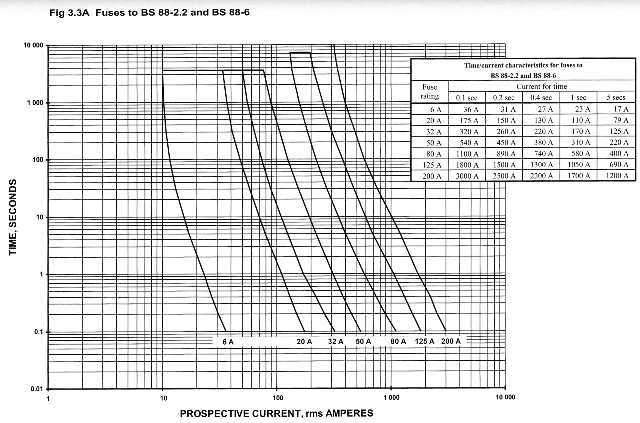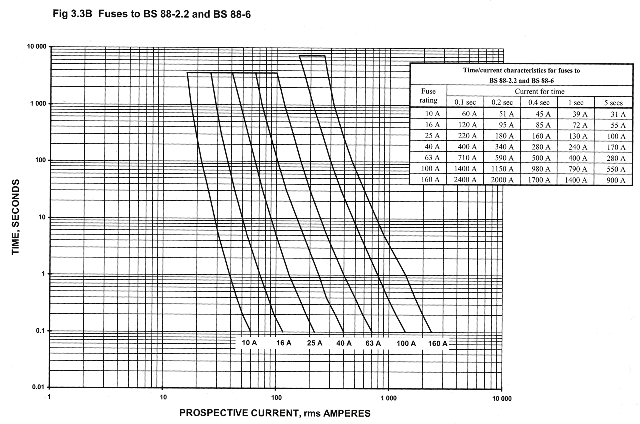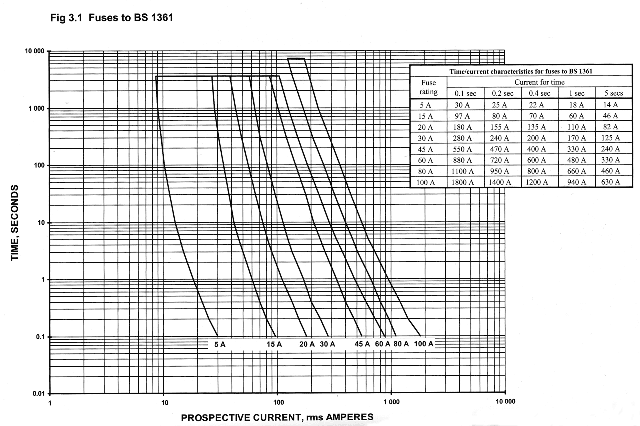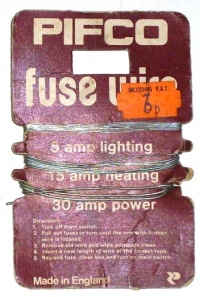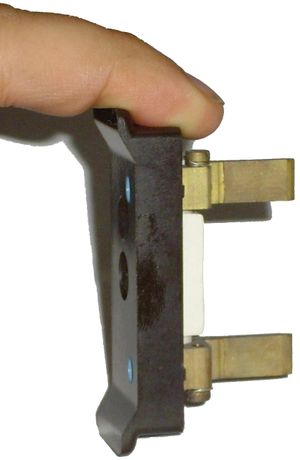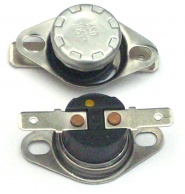Difference between revisions of "Fuse"
(→Glass Fuses: m) |
m (→Mains Plug Fuses: reword) |
||
| (15 intermediate revisions by 2 users not shown) | |||
| Line 40: | Line 40: | ||
;Fusing Characteristics for 3A and 13A BS1362 Plug Fuses | ;Fusing Characteristics for 3A and 13A BS1362 Plug Fuses | ||
| − | [[Image:BS1362FusingTime.png]] | + | [[Image:BS1362FusingTime.png|thumb|left|'''Please Note''' Take care when reading this log/log plot, since it includes an extra division marking the half way point in the first division in each decade - use the printed scale to avoid confusion]] |
| − | The fusing characteristics for 3A and 13A fuses are shown in the | + | The fusing characteristics for 3A and 13A fuses are shown in the graph. To use the graph, look up the prospective fault or overload current along the horizontal axis. Each fuse has a left and right hand line that represents the lower and upper limits of the expected trip time. the vertical space between the two lines for the given current and fuse type indicates the range of time required for disconnection to take place. A current to the left of both lines will be carried indefinitely, and one to the right of both lines will be disconnected "instantly" (or at lease within the normally required tripping time of 0.4 secs - assuming the current is within the breaking capacity of the fuse). |
Modern mains plus fuses are ASTA marked and conform to a standard set of colours. Old fuses that use other colours aren't always the rating they should be. | Modern mains plus fuses are ASTA marked and conform to a standard set of colours. Old fuses that use other colours aren't always the rating they should be. | ||
| Line 64: | Line 64: | ||
===Microwave Ovens=== | ===Microwave Ovens=== | ||
| − | + | Microwave ovens use 2 fuses, mains fuse and HV fuse. | |
| + | The ceramic mains fuses should not be replaced with glass fuses. The fuse inside a microwave is a safety critical component, much more so than other electrical fuses. It is relied on to prevent the user being cooked if the interlock system fails. | ||
| + | |||
| + | The HV fuse is less critical, it does reduce fire risk but there are lots of mcirowaves with no HV fuse in safe use. | ||
| + | |||
| + | Usually the mains fuse is close to the mains flex inlet, and the HV fuse is on the big transformer HV output. | ||
===Wire Link Fuses=== | ===Wire Link Fuses=== | ||
[[image:5A fusewire old 2687-7.jpg|right|140px]] | [[image:5A fusewire old 2687-7.jpg|right|140px]] | ||
| − | As well as their use in [[CU]]s, wire link fuses are occasionally used in low cost | + | As well as their use in [[CU]]s, wire link fuses are occasionally used in low cost [[appliance]]s, such as [[wallwart]]s. These are simply a link of very thin wire. When repairing such goods, if you find a very thin filament of wire in use, it may be a bad idea to replace it with ordinary thicker wire. |
When using fuse wire for fuse links, bear in mind that the fuse rating is dependant on length as well as wire diameter. Standard 5A wire is rated 5A at 1.25", and when shorter lengths are used, the current rating goes up significantly. | When using fuse wire for fuse links, bear in mind that the fuse rating is dependant on length as well as wire diameter. Standard 5A wire is rated 5A at 1.25", and when shorter lengths are used, the current rating goes up significantly. | ||
| − | Although copper (of suitable thickness) can be used as a fuse wire, | + | Although bare copper (of suitable thickness) can be used as a fuse wire, its not generally recommended, as copper reaches very high temperature before it melts. This can cause [[fire]] or destroy the fuseholder. |
===Others=== | ===Others=== | ||
[[image:PCB fuses 770-3.jpg|right|200px]] | [[image:PCB fuses 770-3.jpg|right|200px]] | ||
| − | Other fuse types are also sometimes used in appliances. These include small round encapsulated fuses soldered to a PCB, sometimes surface mount fuses, safety resistors, and less often car type fuses | + | Other fuse types are also sometimes used in appliances. These include small round encapsulated fuses soldered to a PCB, sometimes surface mount fuses, safety resistors, and less often car type fuses. |
| + | There are also a few types of thermal device sometimes used instead of fuses. | ||
| + | *Thermal fuses are an encapsulated low melting point metal link. They're often used in transformers & heaters. | ||
| + | *Disc type thermal cutouts are common. Usually the bimetal disc resets when it cools, but some don't reset. The latter can normally be reset by drilling a hole and pressing the disc back. | ||
| + | *Thermistors are sometimes encountered. These self reset in 5-20 minutes. | ||
==Interpreting Fuse Failure== | ==Interpreting Fuse Failure== | ||
| Line 101: | Line 110: | ||
| − | ==Rewirable Fuses== | + | ==BS3036 Rewirable Fuses== |
[[image:Rewirable_fuse_225-6.jpg|right|200px]] | [[image:Rewirable_fuse_225-6.jpg|right|200px]] | ||
| − | * Widely used in | + | * Widely used in fuseboxes and [[CU]]s |
* Low cost | * Low cost | ||
* Rarely nuisance trip when a [[Filament Lamps|light bulb]] fails. | * Rarely nuisance trip when a [[Filament Lamps|light bulb]] fails. | ||
| − | * Can be abused householders or tenants | + | * Can be abused by householders or tenants fitting thick [[cable|wire]]. |
| − | * Fusing factor requires circuit cable de-rating to 70% of nominal current carrying capacity. | + | * Fusing factor requires circuit [[cable]] de-rating to 70% of nominal current carrying capacity. |
[[MCB]]s have become more popular than rewirable fuses due to pushbutton ease of resetting, and the popular belief that they offer of extra safety because they're newer. For details see [[MCB#Comparison with Fuses|Comparison with Fuses]] | [[MCB]]s have become more popular than rewirable fuses due to pushbutton ease of resetting, and the popular belief that they offer of extra safety because they're newer. For details see [[MCB#Comparison with Fuses|Comparison with Fuses]] | ||
| Line 114: | Line 123: | ||
[[MCB]]s are recommended for let properties, where tenants might abuse rewirable fuses. | [[MCB]]s are recommended for let properties, where tenants might abuse rewirable fuses. | ||
| − | Fuses | + | Fuses have an advantage of less nuisance trips than [[MCB]]s on [[lighting]] circuits (due to [[Lamp Life|bulb failure]]). Where this is a problem, replacing an MCB with a fuse often cures it. |
Fusing response curves (click for enlargement): | Fusing response curves (click for enlargement): | ||
| Line 166: | Line 175: | ||
===Pulling the Incomer Fuse=== | ===Pulling the Incomer Fuse=== | ||
| − | When replacing a CU or fusebox it is necessary to de-energise the supply. Working with live tails is not a good plan. | + | When replacing a [[CU]] or fusebox it is necessary to de-energise the supply. Working with live tails is not a good plan. |
| − | The supply company may de-energise the supply for you, and may fit an isolating switch. Sometimes they won't do it, or will | + | The supply company may de-energise the supply for you, and may fit an isolating switch. Sometimes they won't do it, or will but only at a price. |
| − | Pulling the fuse yourself is not permitted, but for several reasons its generally accepted that supply companies would rather you do that than work live, so have not been known to object or take any action in practice. Pulling live fuses is common practice with professional domestic electricians, and is a much smaller risk than working live. | + | Pulling the fuse yourself is not legally permitted, but for several reasons its generally accepted that supply companies would rather you do that than work live, so have not been known to object or take any action in practice. Pulling live fuses is common practice with professional domestic electricians, and is a much smaller risk than working live. |
==Fuse Safety== | ==Fuse Safety== | ||
| Line 187: | Line 196: | ||
Some older types of [[fusebox]] are designed in such a way that pulling out a fuse carrier with the main switch on is liable to result in electric shock. This is a matter of historic fusebox design rather than safety of the fuse itself. There are many of these boxes still in service; a fuse should not be pulled with power switched on for other reasons too. | Some older types of [[fusebox]] are designed in such a way that pulling out a fuse carrier with the main switch on is liable to result in electric shock. This is a matter of historic fusebox design rather than safety of the fuse itself. There are many of these boxes still in service; a fuse should not be pulled with power switched on for other reasons too. | ||
| + | |||
| + | ==Alternatives== | ||
| + | [[image:Thermal cutouts 5672-2.jpg|right|185px|Bimetal Thermal Cutouts]] | ||
| + | |||
| + | Bimetal thermal cutout. Thermistor. Thermal fuse. Resistor. PCB track (occasionally sized to act as a fuse). | ||
==Refs== | ==Refs== | ||
* [http://www.bussmann.com/library/bifs/2042.PDF Fusing times] | * [http://www.bussmann.com/library/bifs/2042.PDF Fusing times] | ||
| − | |||
==See Also== | ==See Also== | ||
| Line 198: | Line 211: | ||
* [[Special:Categories|Wiki Subject Categories]] | * [[Special:Categories|Wiki Subject Categories]] | ||
* Video clip of [http://www.bs1363.org.uk/counterfeit_fuse.mpeg Counterfeit fuse] blowing | * Video clip of [http://www.bs1363.org.uk/counterfeit_fuse.mpeg Counterfeit fuse] blowing | ||
| − | + | * [http://www.thepoke.co.uk/2014/11/07/great-advice-for-any-diyers-doing-work-this-weekend/ Fuse guide] | |
[[Category:Electrical]] | [[Category:Electrical]] | ||
Revision as of 11:56, 25 May 2017
A Fuse is a thin piece of wire which melts when excess current is passed, thus breaking the circuit.
Fuses are used:
- in mains plugs
- inside appliances
- in the CU or fusebox
- MCBs and RCBOs may be used instead in these
- at the supply company's mains incomer
- and other non-DIY uses
Fuse Ratings
A fuse's rated current is the current it can pass indefinitely in a worst case situation. The current at which it fuses is significantly higher.
- Very slow fusing occurs at currents moderately above rated current
- Very fast fusing occurs at currents several times rated current
To illustrate, a 13A mains plug fuse can pass 25A for about 30 minutes before it blows.
Mains Plug Fuses
BS1362 Mains plug fuses are available in ratings of
- 2A
- 3A
- 5A
- 7A
- 10A
- 13A
- There are also some non-BS1362 1A fuses in use.
3A & 13A are by far the most common plug fuses. 1A, 7A & 10A are not seen often today.
Mains plug fuses use sand filled ceramic cartridges for extra breaking capacity. Do not use glass fuses in mains plugs, these don't have the breaking capacity sometimes required.
The great majority of appliances are safe on a 13A fuse, but there are certainly exceptions, mostly old equipment. Using a lower fuse value where possible can reduce risk of fire. Discussion of this.
- Fusing Characteristics for 3A and 13A BS1362 Plug Fuses
The fusing characteristics for 3A and 13A fuses are shown in the graph. To use the graph, look up the prospective fault or overload current along the horizontal axis. Each fuse has a left and right hand line that represents the lower and upper limits of the expected trip time. the vertical space between the two lines for the given current and fuse type indicates the range of time required for disconnection to take place. A current to the left of both lines will be carried indefinitely, and one to the right of both lines will be disconnected "instantly" (or at lease within the normally required tripping time of 0.4 secs - assuming the current is within the breaking capacity of the fuse).
Modern mains plus fuses are ASTA marked and conform to a standard set of colours. Old fuses that use other colours aren't always the rating they should be.
Equipment Fuses
Glass Fuses
20mm & the older 1.25" glass fuses are widely used in appliances. There are 3 common types of these fuses:
- Quick blow
- Slow blow
- Time delay
The type is indicated by the construction inside the glass and the marking on one metal endcap.
Example markings:
- F1A - 1A quick blow fuse, uses a plain fuse wire.
- T2A - slow blow 2A, uses fuse wire with a few small nodules on it
- T5A - time delay 5A, uses a spring & solder joint
The slow blow 'nodules' and time delay 'spring' types of fuses are not equivalent, time delays blow a good deal slower than slow blow, and that extra time delay is needed in some applications, such as where relatively high internal switch on currents are involved, as is routinely the case inside appliance power supplies and with motors.
Microwave Ovens
Microwave ovens use 2 fuses, mains fuse and HV fuse.
The ceramic mains fuses should not be replaced with glass fuses. The fuse inside a microwave is a safety critical component, much more so than other electrical fuses. It is relied on to prevent the user being cooked if the interlock system fails.
The HV fuse is less critical, it does reduce fire risk but there are lots of mcirowaves with no HV fuse in safe use.
Usually the mains fuse is close to the mains flex inlet, and the HV fuse is on the big transformer HV output.
Wire Link Fuses
As well as their use in CUs, wire link fuses are occasionally used in low cost appliances, such as wallwarts. These are simply a link of very thin wire. When repairing such goods, if you find a very thin filament of wire in use, it may be a bad idea to replace it with ordinary thicker wire.
When using fuse wire for fuse links, bear in mind that the fuse rating is dependant on length as well as wire diameter. Standard 5A wire is rated 5A at 1.25", and when shorter lengths are used, the current rating goes up significantly.
Although bare copper (of suitable thickness) can be used as a fuse wire, its not generally recommended, as copper reaches very high temperature before it melts. This can cause fire or destroy the fuseholder.
Others
Other fuse types are also sometimes used in appliances. These include small round encapsulated fuses soldered to a PCB, sometimes surface mount fuses, safety resistors, and less often car type fuses.
There are also a few types of thermal device sometimes used instead of fuses.
- Thermal fuses are an encapsulated low melting point metal link. They're often used in transformers & heaters.
- Disc type thermal cutouts are common. Usually the bimetal disc resets when it cools, but some don't reset. The latter can normally be reset by drilling a hole and pressing the disc back.
- Thermistors are sometimes encountered. These self reset in 5-20 minutes.
Interpreting Fuse Failure
It is possible to glean some information about the nature of the fault that caused a fuse to blow:
- Wire ends melted, surroundings clean: moderate overload, very slow blow.
- Wire ends melted, surroundings clean, but signs of overheating of the fuseholder: long standing moderate overload, eventual blow.
- Wire ends melted, a little blackening around fuse wire: fairly large overload current, quick blow.
- Just a blackened mess: Very high overload current, very fast blow.
- Surroundings clean, no blob of molten fusewire on either broken end: fusewire fractured due to mechanical causes, not an overload fault. Typically seen with very low current fuses (2A and below) and glass fuses with a loose end.
Low Voltage Fuses
All fuses have a voltage rating above which they may be unable to break the circuit.
Fuses designed for vehicles are usually 32v rated, and should never be used at mains voltage, as they are likely to be unable to stop the flow of current.
20mm glass fuses should not be used to replace better specified fuses, 20mm have very low current breaking ratings inadequate for many mains voltage applications.
Mains fuses can safely be used at lower voltage. The lower voltage doesn't affect their current rating.
BS3036 Rewirable Fuses
- Widely used in fuseboxes and CUs
- Low cost
- Rarely nuisance trip when a light bulb fails.
- Can be abused by householders or tenants fitting thick wire.
- Fusing factor requires circuit cable de-rating to 70% of nominal current carrying capacity.
MCBs have become more popular than rewirable fuses due to pushbutton ease of resetting, and the popular belief that they offer of extra safety because they're newer. For details see Comparison with Fuses
MCBs are recommended for let properties, where tenants might abuse rewirable fuses.
Fuses have an advantage of less nuisance trips than MCBs on lighting circuits (due to bulb failure). Where this is a problem, replacing an MCB with a fuse often cures it.
Fusing response curves (click for enlargement):
Fuse wire sizes
Sizes of tinned copper wire for use in semi-enclosed fuses
| Nominal current of fuse element (A) | Nominal diameter of wire (mm) |
|---|---|
| 3 | 0.15 |
| 5 | 0.20 |
| 10 | 0.35 |
| 15 | 0.50 |
| 20 | 0.60 |
| 25 | 0.75 |
| 30 | 0.85 |
| 45 | 1.25 |
| 60 | 1.53 |
| 80 | 1.80 |
| 100 | 2.00 |
Incomer Fuses (BS 88 "HRC" & BS 1361)
BS 88 & BS 1361 Type II fuses are used in electrical mains incomers. This is where the mains supply enters the property, before the meter.
Fusing time response curves. Click for enlargement:
Pulling the Incomer Fuse
When replacing a CU or fusebox it is necessary to de-energise the supply. Working with live tails is not a good plan.
The supply company may de-energise the supply for you, and may fit an isolating switch. Sometimes they won't do it, or will but only at a price.
Pulling the fuse yourself is not legally permitted, but for several reasons its generally accepted that supply companies would rather you do that than work live, so have not been known to object or take any action in practice. Pulling live fuses is common practice with professional domestic electricians, and is a much smaller risk than working live.
Fuse Safety
Fuses are safety devices, serving to prevent many cases of fire, shock and equipment damage.
Abuse
The one significant issue with fuses is the tendency of some users to remove the fuse and replace it with something ineffective, such as thicker wire or a bolt. A card of fusewire kept on the fusebox eliminates most such temptation.
Rating
Fuses permit some amount of sustained overload, so cables protected by fuses which might be run at above the fuse rating, in particular domestic ring circuits, need to be able to safely carry more than the fuse's rated capacity. The degree of difference in this overcurrent between fuse and MCB is why there is a difference in rating between 30A fuses and 32A MCBs used on ring circuits.
A Common Fusebox Design Issue
Some older types of fusebox are designed in such a way that pulling out a fuse carrier with the main switch on is liable to result in electric shock. This is a matter of historic fusebox design rather than safety of the fuse itself. There are many of these boxes still in service; a fuse should not be pulled with power switched on for other reasons too.
Alternatives
Bimetal thermal cutout. Thermistor. Thermal fuse. Resistor. PCB track (occasionally sized to act as a fuse).
Refs
See Also
- MCB
- MCB Comparison with Fuses
- Wiki Contents
- Wiki Subject Categories
- Video clip of Counterfeit fuse blowing
- Fuse guide
